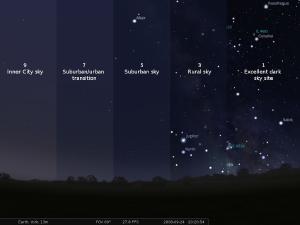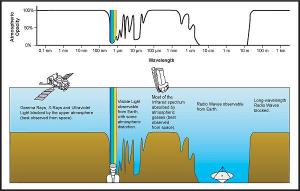Post
A Blanket of Sky
6 April 2013
 Stellarium (public domain), Sky & Telescope
Stellarium (public domain), Sky & TelescopeIf you hang around astronomers for a while, you will soon hear about the problems of light pollution. This is particularly true for amateur astronomers, and rightfully so. Unlike professional astronomers they aren’t likely to have access to telescopes in remote parts of the world, and so the ever increasing use of night lighting affects them more critically. Light pollution is one example of the challenges of Earth-based astronomy. Specifically the atmosphere that surrounds our planet.
 NASA/IPAC
NASA/IPACYou probably think of the atmosphere as being clear. As long as there are no clouds in the sky, and the night is dark, then our atmosphere looks pretty transparent. That’s true at the wavelengths of visible light, but not for every wavelength. At some wavelengths of light the atmosphere is relatively clear, but at others it is very opaque. You can see this in the figure, which shows the transparency of different wavelengths as dips in the overall line.
At wavelengths shorter than the visible spectrum, our atmosphere is almost completely opaque. This is a good thing, since things like ultraviolet light, x-rays can be pretty harmful in large enough doses. That region just to the left of the visible spectrum allows just enough ultraviolet light through to give you a sunburn if we’re not careful. Just to the right of the visible wavelengths, in the range known infrared, you’ll notice a series of dips where the atmosphere is reasonably transparent. This means there are narrow regions where ground based astronomy can be effective. You’ll also notice a wide frequency range at radio wavelengths where our atmosphere is entirely clear. At these wavelengths the atmosphere has little effect on observations.
Much of the opacity of our sky is actually due to water vapor. Water vapor absorbs very long wavelengths as well as most of the regions in the infrared. Consequently, it’s actually water vapor that is the primary “greenhouse gas” in our atmosphere. Carbon dioxide is number two. Because of this, optical telescopes are typically located in high, dry locations to reduce the amount of light absorption.
Light pollution can also be a problem at wavelengths other than light. For example, the heat of our atmosphere means it emits infrared radiation. This means that some of the transparent regions in the infrared can be plagued by infrared light pollution. Radio astronomers sometimes have to deal with interference from Earth-based radio transmissions. This is one of the reasons for the National radio quiet zone in a region of West Virginia and Virginia.
Of course you can avoid all these problems by simply putting your telescope above the atmosphere. That poses its own set of challenges, not the least of which is cost. For x-ray astronomy and much of the infrared, there is simply no alternative, so space-based astronomy is the only option. For everything else, the challenge is often to find clever ways to minimize the effects of the atmosphere and light pollution.
Fortunately, there are a lot of clever astronomers out there.